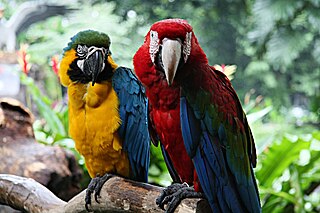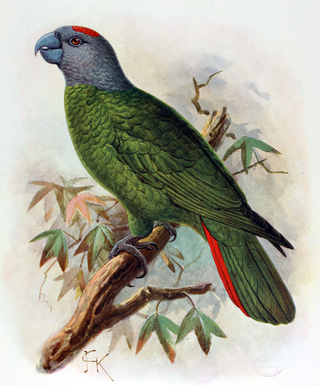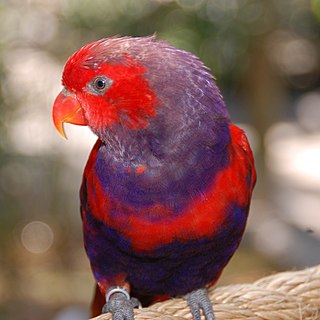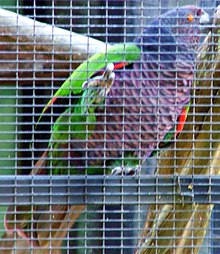
Amazon parrots are parrots in the genus Amazona. They are medium-sized, short-tailed parrots native to the Americas, with their range extending from South America to Mexico and the Caribbean. Amazona is one of the 92 genera of parrots that make up the order Psittaciformes and is in the family Psittacidae, one of three families of true parrots. It contains about thirty species. Most amazons are predominantly green, with accenting colors that depend on the species, and they can be quite vivid. They feed primarily on seeds, nuts, and fruits, supplemented by leafy matter.

The flag of Dominica was adopted on 3 November 1978, with some small changes having been made in 1981, 1988, and 1990. The original flag was designed by playwright Alwin Bully in early 1978 as the country prepared for independence.

Caique refers to a group of four species of parrots in the genus Pionites endemic to the Amazon Basin in South America.

The red-necked amazon, also known as the red-necked parrot, Dominican blue-faced amazon, lesser Dominican amazon, and jaco parrot or jaco, is an amazon parrot endemic to Dominica.

The Puerto Rican amazon, also known as the Puerto Rican parrot or iguaca, is the only extant parrot endemic to the archipelago of Puerto Rico, and belongs to the Neotropical genus Amazona. Measuring 28–30 cm (11.0–11.8 in), the bird is a predominantly green parrot with a red forehead and white rings around the eyes. Its closest relatives are believed to be the Cuban amazon and the Hispaniolan amazon.

The lilac-crowned amazon, also known as lilac-crowned parrot, Finsch's parrot or Finsch's amazon, is a parrot endemic to the Pacific slopes of Mexico. Also known as Finsch's amazon, it is characterised by green plumage, a maroon forehead, and a violet-blue crown and neck.

Ara is a Neotropical genus of macaws with eight extant species and at least two extinct species. The genus name was coined by French naturalist Bernard Germain de Lacépède in 1799. It gives its name to and is part of the Arini, or tribe of Neotropical parrots. The genus name Ara is derived from the Tupi word ará, an onomatopoeia of the sound a macaw makes.

The Saint Vincent amazon, also known as Saint Vincent parrot, is a large, approximately 40 cm (16 in) long, multi-colored amazon parrot with a yellowish white, blue and green head, greenish-bronze upperparts plumage, and violet blue-green wings.

The red-tailed amazon, also known as the red-tailed parrot, is a species of parrot in the family Psittacidae. It is endemic to coastal regions in the south-east Brazilian states of São Paulo and Paraná. The bird has been threatened by habitat loss and capture for the wild bird trade, and is a symbol of the efforts to conserve one of the Earth's most biologically diverse ecosystems. Consequently, it is considered Near Threatened by BirdLife International and the IUCN. In 1991–92, the population had fallen below 2000 individuals. Following on-going conservation efforts, a count and estimate from 2015 suggests a population of 9,000–10,000, indicating that this species is recovering from earlier persecution. A recent study shows that the population of this species is stable at Paraná state, Southern Brazil, revealing population trend fluctuation during the last 12 years.

The yellow-billed amazon, also called the yellow-billed parrot or Jamaican amazon, is a species of parrot in the family Psittacidae. It is a predominantly green parrot with a short tail and pink throat and neck. It is endemic to Jamaica, where its natural habitats are subtropical or tropical moist lowland forests, subtropical or tropical mangrove forests, subtropical or tropical moist montane forests, plantations, and rural gardens. It is threatened by habitat loss and illegal trapping of wild birds for the pet trade.

Kawall's amazon, also known as the white-faced amazon, white-cheeked amazon or Kawall's parrot, is a relatively large species of parrot in the family Psittacidae. It is endemic to the south-central Amazon. After not having been recorded in the wild for around 70 years, the species was rediscovered in the 1980s.

The Martinique amazon is a hypothetical extinct species of Caribbean parrot in the family Psittacidae. It is not known from any material remains, but was said to be similar to the red-necked amazon from Dominica, the next major island to the north of Martinique. Natives are known to have traded extensively in parrots between the Antilles, and it seems that the Martinique population was in some way related to or even descended from A. arausiaca.

The red-spectacled amazon is a species of parrot in the family Psittacidae. It is found in Argentina, Brazil, and Paraguay.

The red-browed amazon is a species of parrot in the family Psittacidae. It is endemic to Atlantic Forest in eastern Brazil. It has been considered a subspecies of the blue-cheeked amazon, but today all major authorities consider them separate species. It is threatened both by habitat loss and by being captured for the trade in wild parrots.

The Tucumán amazon, also known as the Tucumán parrot, alder amazon, or alder parrot, is a vulnerable species of bird in subfamily Arinae of the family Psittacidae, the African and New World parrots. It is found in Argentina and Bolivia.

The Saint Lucia amazon, also known as the St. Lucia amazon and St. Lucia parrot, is a Vulnerable species of bird in subfamily Arinae of the family Psittacidae, the African and New World parrots. It is endemic to Saint Lucia in the Lesser Antilles and is the country's national bird.

The vinaceous-breasted amazon, also called the vinaceous-breasted parrot and occasionally simply vinaceous amazon/parrot is an endangered species of bird in subfamily Arinae of the family Psittacidae, the African and New World parrots. It is found in Argentina, Brazil, and Paraguay.

The Guadeloupe amazon or Guadeloupe parrot is a hypothetical extinct species of parrot that is thought to have been endemic to the Lesser Antillean island region of Guadeloupe. Mentioned and described by 17th- and 18th-century writers, it received a scientific name in 1789. It was moved to the genus Amazona in 1905, and is thought to have been related to, or possibly the same as, the extant imperial amazon. A tibiotarsus and an ulna bone from the island of Marie-Galante may belong to the Guadeloupe amazon. In 1905, a species of extinct violet macaw was also claimed to have lived on Guadeloupe, but in 2015, it was suggested to have been based on a description of the Guadeloupe amazon.

Eos is a genus of parrots belonging to the lories and lorikeets tribe of the family Psittaculidae. There are six species which are all endemic to islands of eastern Indonesia, most within very restricted ranges. They have predominantly red plumage with blue, purple or black markings. Males and females are similar in appearance.

The diademed amazon is a parrot in the family Psittacidae formerly considered conspecific with the red-lored amazon. Amazona diadema is restricted to the state of Amazonas in north-western Brazil.
























